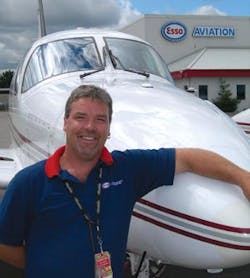Most airline passengers only get to see their bags being moved on the ramp but if you watch closely then you will see that this is only the smallest part of ramp work.Safely handling the needs of a multi-million dollar aircraft and its passengers takes professionalism and dedication. From extreme heat in the summer to the dangers of ice and snow on the ramp in winter, the job is never boring. Jet engines and spinning propellers are always around you, so you must keep alert to be safe. It takes a special kind of person to earn a living in this kind of environment. Here are a few ramp professionals from Toronto’s Pearson and Hamilton’s Munro Airports.
From One Generation to the Next
Rob Davidson has been at the Hamilton Airport for 20 years. He is the line crew supervisor for Marsh Brothers Esso Avitat and he is also the reason that many pilots go out of their way to return time and again. Davidson’s smiling face, warm welcome and superior customer service set him apart as a company representative and team leader.
You only have to spend a few minutes around Rob to see why he is so good at what he does. He puts 100 percent into everything he does and he expects the same from those around him. But he makes it fun, it doesn’t feel like work when he’s around. You can tell he really enjoys the ramp and his enthusiasm is contagious.
Christine Brown is a 24-year-old ramp lead working for GlobeGround at Toronto’s Pearson International Airport. She has been on the ramp for about 1?½ years and has been a lead for the past nine months. Her crew handles the big commercial jets and her responsibilities are different from the smaller FBO’s that handle business aviation.
There is a lot of work to be done in a short time. Bags, water and lavs, ground power and finally safe pushback and engine starts must all be completed in 30 minutes. Her job requires not only knowledge of the aircraft but also good people management skills. Team work is essential in this kind of ramp work. Delays are costly and not tolerated by airlines or passengers.
Brian Henderson is a 21-year-old ramp agent who also works for GlobeGround at Pearson Airport. He has also worked the ramp for 1?½ years and has passed his qualification to be a lead. It’s easy to spot Henderson on the ramp, due in large part to his bright orange Mohawk hair cut. But don’t let the hair fool you, Henderson is every bit the ramp professional he needs to be, to get the job done.
Hiring for the Ramp
Anyone who has spent any time at all on the ramp at a busy international airport will know that it takes a special kind of person to do the job. Ground service companies are constantly searching for new employees to fill the void left by workers that have moved on. It is estimated that less than 40 percent of the new workers will stay with the company after the first few months.
Airlines, with record high operating costs, are only willing to pay so much for ground services, and this directly effects the pay and benefits that the ground service companies can offer to their workers.
Take a quick look around the ramp and you will see the average ramp worker is under 25 years of age. These young people generally don’t have any ramp experience and are just looking for steady work and a new experience. Many soon realize that the ramp is not for them.
Just getting the job can be difficult. There are police security checks, ramp driver’s license exams, security passes, aircraft safety courses, drug tests, personal history checks and constant supervision.
Some of the younger ramp workers have other qualifications such as pilot, air traffic controller or apprentice aircraft mechanic. After graduating their courses they can’t find work so they join the ramp crew to get their security clearances and to shop around for a better job at the airport. Most young ramp workers don’t consider it a career, but rather a stepping stone.
Unfortunately the constant recruiting and training of new employees is contributing to overall operating costs and limiting the pay and benefits that ground service companies can provide. The challenge for ground service operators is to find a way to keep good employees from leaving.
Pay incentives, promotions to leadership rolls, monthly moral boosting contests, teamwork building exercises, friendly and concerned management, these are a few strategies that can be employed by companies to help keep their young work force interested and focused on their jobs.
Compare the cost of training a new employee to the cost of starting incentive based programs to help keep the workers you have. Get them involved in the decisions that directly affect their working conditions. Empower your employees and you may find that they will work with you instead of for you.
Honoring our Ramp Workers
If you have a co-worker or employee that you would like to tell us about, someone who stands out and should be recognized. Then take some photos and write a few paragraphs about them and send it to us here at Ground Support Magazine. We would be happy to pass on a well deserved pat on the back. We started in southern Ontario Canada now lets see where this takes us. It’s time to sound off and stand proud of the work we do every day to keep aircraft and passengers moving.





